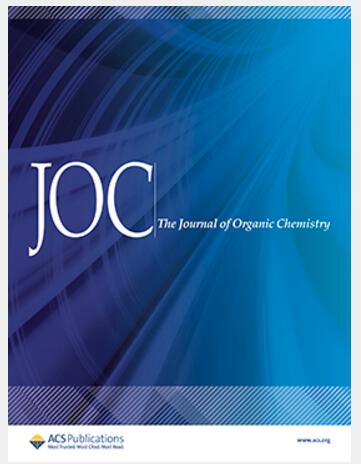Computational Rational Design of Bridgehead Nitrogen Heterocyclic Azobenzene Photoswitches.
IF 3.3
2区 化学
Q1 CHEMISTRY, ORGANIC
引用次数: 0
Abstract
Azobenzenes are proven to be one of the most successful molecular photoswitches applied across different fields such as organic chemistry, material science, cosmetics, and pharmaceuticals. Such a widespread implementation is possible because of their photochromic properties contingent upon the substitution pattern and aryl-core nature. In recent endeavors of molecular design, replacing one or both phenyl rings with heteroaromatics turned out to be a good strategy to access compounds with improved photoswitching properties, as well as to expand molecular diversity. One of the challenges related to the design of new azobenzene photoswitches is that it often includes the synthesis of large libraries of compounds due to limited methods for prediction of their properties. Herein, we present a computationally driven workflow for the design and synthesis of a novel class of azobenzene photoswitches, heteroaryl azobenzenes with N-bridgehead heterocycles─pyrazolo[1,5-a]pyrimidine and 1,2,4-triazolo[1,5-a]pyrimidine. A small library of heteroaryl photoswitches was synthesized, and their photochemical properties were evaluated. Subsequently, these results were used to validate a computational approach, which included the in silico evaluation of a large library of designed photoswitch candidates leading to the synthesis of a new photoswitch with improved spectral properties, red-shifted λmax values.桥头堡氮杂环偶氮光开关的计算合理设计。
偶氮苯被证明是最成功的分子光开关之一,应用于有机化学、材料科学、化妆品和制药等不同领域。这种广泛的实施是可能的,因为它们的光致变色性质取决于取代模式和芳基核性质。在最近的分子设计中,用杂芳烃取代一个或两个苯基环被证明是获得具有改善光电特性的化合物和扩大分子多样性的良好策略。与设计新型偶氮苯光开关相关的挑战之一是,由于预测其性质的方法有限,通常需要合成大量化合物库。在此,我们提出了一种计算驱动的工作流程,用于设计和合成一类新型偶氮苯光开关,具有n -桥头堡杂环的杂芳基偶氮苯─吡唑[1,5-a]嘧啶和1,2,4-三唑[1,5-a]嘧啶。合成了一个小的杂芳基光开关库,并对其光化学性质进行了评价。随后,这些结果被用于验证一种计算方法,其中包括对大量设计的候选光开关进行计算机评估,从而合成具有改进光谱特性的新光开关,红移λmax值。
本文章由计算机程序翻译,如有差异,请以英文原文为准。
求助全文
约1分钟内获得全文
求助全文
来源期刊

Journal of Organic Chemistry
化学-有机化学
CiteScore
6.20
自引率
11.10%
发文量
1467
审稿时长
2 months
期刊介绍:
Journal of Organic Chemistry welcomes original contributions of fundamental research in all branches of the theory and practice of organic chemistry. In selecting manuscripts for publication, the editors place emphasis on the quality and novelty of the work, as well as the breadth of interest to the organic chemistry community.
 求助内容:
求助内容: 应助结果提醒方式:
应助结果提醒方式:


